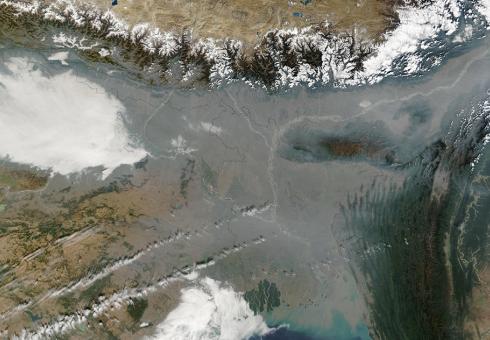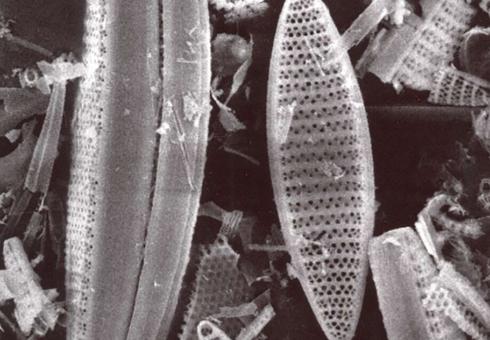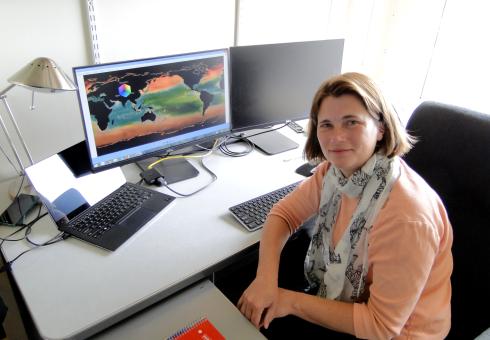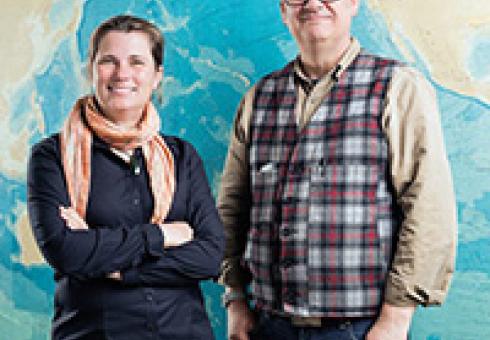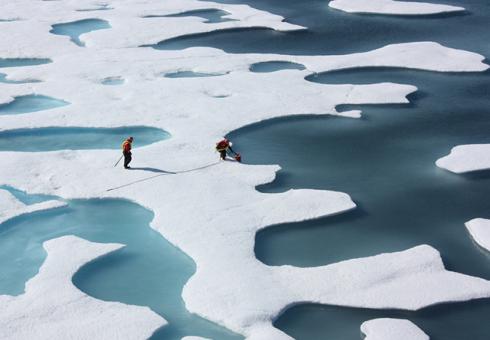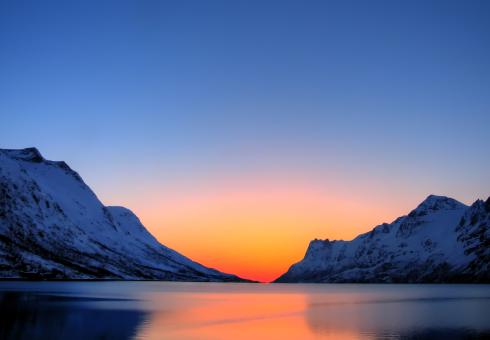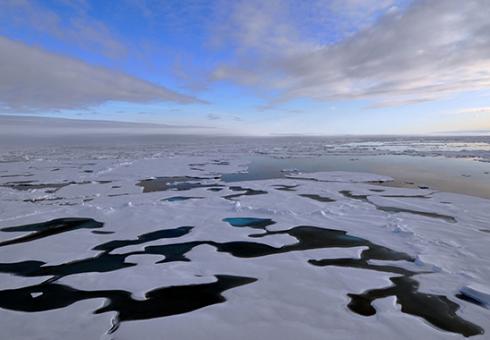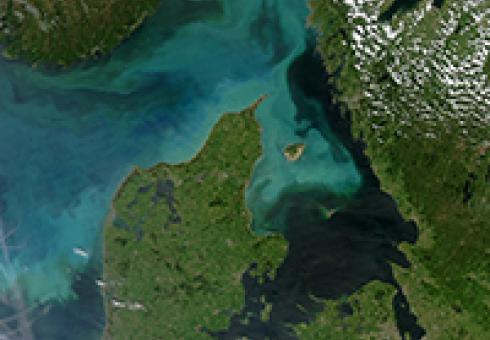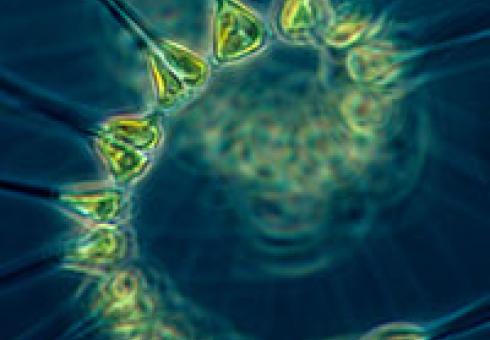Joint Program researchers advocate for improved modeling approach
News and Outreach: Stephanie Dutkiewicz
Study's co-authors, including MIT Joint Program-affiliated research scientist Stephanie Dutkiewicz, argue that ecosystem models should account for the diversity of diatoms to better predict the fate of these micro-algae and their role in the biological carbon pump of tomorrow's ocean
Modeling the diverse world of phytoplankton opens up a predictive view of our own
Study finds many species may die out and others may migrate significantly as ocean acidification intensifies.
by Jennifer Chu | MIT News Office
Oceans have absorbed up to 30 percent of human-made carbon dioxide around the world, storing dissolved carbon for hundreds of years. As the uptake of carbon dioxide has increased in the last century, so has the acidity of oceans worldwide. Since pre-industrial times, the pH of the oceans has dropped from an average of 8.2 to 8.1 today. Projections of climate change estimate that by the year 2100, this number will drop further, to around 7.8 — significantly lower than any levels seen in open ocean marine communities today.
Now a team of researchers from MIT, the University of Alabama, and elsewhere has found that such increased ocean acidification will dramatically affect global populations of phytoplankton — microorganisms on the ocean surface that make up the base of the marine food chain.
In a study published today in the journal Nature Climate Change, the researchers report that increased ocean acidification by 2100 will spur a range of responses in phytoplankton: Some species will die out, while others will flourish, changing the balance of plankton species around the world.
The researchers also compared phytoplankton’s response not only to ocean acidification, but also to other projected drivers of climate change, such as warming temperatures and lower nutrient supplies. For instance, the team used a numerical model to see how phytoplankton as a whole will migrate significantly, with most populations shifting toward the poles as the planet warms. Based on global simulations, however, they found the most dramatic effects stemmed from ocean acidification.
Stephanie Dutkiewicz, a principal research scientist in MIT’s Center for Global Change Science, says that while scientists have suspected ocean acidification might affect marine populations, the group’s results suggest a much larger upheaval of phytoplankton — and therefore probably the species that feed on them — than previously estimated.
“I’ve always been a total believer in climate change, and I try not to be an alarmist, because it’s not good for anyone,” says Dutkiewicz, who is the paper’s lead author. “But I was actually quite shocked by the results. The fact that there are so many different possible changes, that different phytoplankton respond differently, means there might be some quite traumatic changes in the communities over the course of the 21st century. A whole rearrangement of the communities means something to both the food web further up, but also for things like cycling of carbon.”
The paper’s co-authors include Mick Follows, an associate professor in MIT’s Department of Earth, Atmospheric and Planetary Sciences.
Winners and losers
To get a sense for how individual species of phytoplankton react to a more acidic environment, the team performed a meta-analysis, compiling data from 49 papers in which others have studied how single species grow at lower pH levels. Such experiments typically involve placing organisms in a flask and recording their biomass in solutions of varying acidity.
In all, the papers examined 154 experiments of phytoplankton. The researchers divided the species into six general, functional groups, including diatoms, Prochlorococcus, and coccolithophores, then charted the growth rates under more acidic conditions. They found a whole range of responses to increasing acidity, even within functional groups, with some “winners” that grew faster than normal, while other “losers” died out.
The experimental data largely reflected individual species’ response in a controlled laboratory environment. The researchers then worked the experimental data into a global ocean circulation model to see how multiple species, competing with each other, responded to rising acidity levels.
The researchers paired MIT’s global circulation model — which simulates physical phenomena such as ocean currents, temperatures, and salinity — with an ecosystem model that simulates the behavior of 96 species of phytoplankton. As with the experimental data, the researchers grouped the 96 species into six functional groups, then assigned each group a range of responses to ocean acidification, based on the ranges observed in the experiments.
Natural competition off balance
After running the global simulation several times with different combinations of responses for the 96 species, the researchers observed that as ocean acidification prompted some species to grow faster, and others slower, it also changed the natural competition between species.
“Normally, over evolutionary time, things come to a stable point where multiple species can live together,” Dutkiewicz says. “But if one of them gets a boost, even though the other might get a boost, but not as big, it might get outcompeted. So you might get whole species just disappearing because responses are slightly different.”
Dutkiewicz says shifting competition at the plankton level may have big ramifications further up in the food chain.
“Generally, a polar bear eats things that start feeding on a diatom, and is probably not fed by something that feeds on Prochlorococcus, for example,” Dutkiewicz says. “The whole food chain is going to be different.”
By 2100, the local composition of the oceans may also look very different due to warming water: The model predicts that many phytoplankton species will move toward the poles. That means that in New England, for instance, marine communities may look very different in the next century.
“If you went to Boston Harbor and pulled up a cup of water and looked under a microscope, you’d see very different species later on,” Dutkiewicz says. “By 2100, you’d see ones that were living maybe closer to North Carolina now, up near Boston.”
Dutkiewicz says the model gives a broad-brush picture of how ocean acidification may change the marine world. To get a more accurate picture, she says, more experiments are needed, involving multiple species to encourage competition in a natural environment.
“Bottom line is, we need to know how competition is important as oceans become more acidic,” she says.
This research was funded in part by the National Science Foundation, and the Gordon and Betty Moore Foundation.
Oceans cover 97 percent of the Earth’s surface, and act as an important carbon sink. However, each part of the ocean works in different ways to take up carbon from the atmosphere and store it. Two new studies shed light on the nuances how these processes work in the Arctic Ocean and coastal zones.
The findings about the Arctic Ocean were published recently in the journal Global Biogeochemical Cycles. Stephanie Dutkiewicz, a research scientist at the Massachusetts Institute for Technology, worked with colleagues to figure out how decreasing sea ice in the summer is affecting the carbon cycle in that ocean basin from 1997-2006.
That period is in the middle a timeframe when the Arctic has been warming twice as fast as the rest of the globe, leading to major losses in sea ice, which hit a record low in 2012. Over that time, the Arctic Ocean has become a greater repository for carbon.
That’s because more open water provides more suitable habitat for phytoplankton, or algae, to grow and suck carbon dioxide out of the air. As days get shorter, the algae dies and sinks, sequestering the carbon at the bottom of the ocean.
With summer loss of sea ice and warming in the Arctic projected to continue, phytoplankton blooms are likely to be a more common occurance across the region. However, the warming trend encouraging algae growth could also have negative consequences on another ocean mechanism that removes carbon from the atmosphere.
Sunlight not only increases plant life but it also warms the surface waters of the Arctic. Dutkiewicz’s findings show that warming could eventually reduce the Arctic Ocean’s ability to absorb carbon dioxide because cold water dissolves it better than warm water.
Of course water is warming in a relative sense in the Arctic. Sea surface temperatures in the region have risen since 1965 but are still near freezing for most of the region during the summer. However, if the trend continues it could still reduce the region’s ability to take up carbon. Dutkiewicz also said the study’s findings have applications beyond the Arctic’s borders.
“The processes we’re looking at are happening everywhere,” Dutkiewicz said. “We need to be studying it (in the Arctic) and understanding the changes. That will help us understand what will happen in 20 or 50 years in other parts of other oceans.”
The other study, a review published in Nature, found that coastal oceans are also helping store carbon. Coastals oceans account for only 7 percent of the overall area of oceans, but the new study finds they play an outsize role when it comes to carbon storage.
Coastal zones weren’t always carbon sinks. Prior to the Industrial Revolution, oceans acted as net emitters of carbon. However, in the ensuing 50-100 years, a shift occurred and these areas now take up more carbon than they emit.
The new research estimates that in pre-industrial times, coastal areas emitted about 150 million metric tons of carbon a year. Presently they take up 250 million metric tons annually. That’s about equivalent to Turkey’s carbon emissions in 2008.
“Traditionally, most thinking has been that there’s a shift in biological production in recent decades, that the ocean has become more productive,” said Wei-Jun Cai, an oceanographer at the University of Delaware and author of the report. The reason, he said, is because increased runoff from agriculture finds it way down rivers and into the coastal zone, which in turn increases plant life.
However, Cai believes there’s another mechanism at play. Measurements in the open ocean of carbon dioxide in the water and the atmosphere tend to show the two stay pretty close to equilibrium. In other words, if there’s 400 parts per million of carbon dioxide in the atmosphere, a similar ratio is likely to exist in the ocean waters.
That relationship doesn’t exist in coastal areas, though. Cai recalled a trip to measure carbon dioxide in the water off the Georgia coast in 2005.
“It was very similar to what someone else measured in 1995,” he said about his measurements. “I was shocked as there was very little increase. The reason is the water doesn’t stay there for a long enough time so it doesn’t really accumulate the anthropogenic signal.”
Instead, water in coastal zones is constantly on the move thanks to the conveyor belt of ocean currents. Those currents eventually dive to the depth of the ocean, and could be storing the carbon down there according to Cai’s theory.
Both studies point to the need for better monitoring in both those regions. They offer tantalizing results that suggest revisiting our understanding of the globe’s carbon budget, but more data is needed to reinforce their results.
That data would not only inform a better understanding of the planet’s carbon budget, but also paint a clearer picture of how regions that have great economic and environmental importance are changing.
The Arctic Ocean has has long been known as a carbon sink, but a new study suggests that while the frigid waters do store large quantities of carbon, parts of the ocean also emit atmospheric carbon dioxide.
Researchers from MIT constructed a model to simulate the effect of sea ice loss in the Arctic, finding that as the region loses its ice, it is becoming more of a carbon sink, taking on about one additional megaton of carbon each year between 1996 and 2007. But while the Arctic is taking on more carbon, the researchers found, paradoxically, the regions where the water is warmest are actually able to store less carbon and are instead emitting carbon dioxide into the atmosphere.
While the Arctic region as a whole remains a large carbon sink, the realization that parts of the Arctic are carbon emitters paints a more complex picture of how the region is responding to global warming.
"People have suggested that the Arctic is having higher productivity, and therefore higher uptake of carbon," said Stephanie Dutkiewicz, an MIT research scientist. "What's nice about this study is, it says that's not the whole story. We've begun to pull apart the actual bits and pieces that are going on."
Dutkiewicz and her colleagues, including Mick Follows and Christopher Hill of MIT, Manfredi Manizza of the Scripps Institute of Oceanography and Dimitris Menemenlis of NASA's Jet Propulsion Laboratory, published their work in the journal Global Biogeochemical Cycles.
To model the Arctic's carbon cycle, the research team developed a model that traces the flow of carbon in the Arctic, looking for conditions that led to the ocean's storage or release of carbon. To accomplish this, the team incorporated three models, which MIT detailed in a news release:
"A physical model that integrates temperature and salinity data, along with the direction of currents in a region; a sea ice model that estimates ice growth and shrinkage from year to year; and a biogeochemistry model, which simulates the flow of nutrients and carbon, given the parameters of the other two models."
The model showed the Arctic taking on an average of 58 megatons of carbon each year, with an average increase of 1 megaton each year between 1996 and 2007. One megaton is 1 million tons.
The model confirms a long held theory: as sea ice melts, more organisms grow, leading to a larger carbon sink as the organisms store carbon.
But there was the anomaly of 2005-2007 where portions of the Arctic released more carbon than they stored. These years saw significant sea ice shrinkage, yet in certain regions, more carbon was emitted than stored. The researchers accounted for the anomaly by factoring in water temperature along with the levels of sea ice loss.
"The Arctic is special in that it's certainly a place where we see changes happening faster than anywhere else," Dutkiewicz said. "Because of that, there are bigger changes in the sea ice and biology, and therefore possibly to the carbon sink."
Jennifer Chu, MIT News Office
For the past three decades, as the climate has warmed, the massive plates of sea ice in the Arctic Ocean have shrunk: In 2007, scientists observed nearly 50 percent less summer ice than had been seen in 1980.
Dramatic changes in ice cover have, in turn, altered the Arctic ecosystem — particularly in summer months, when ice recedes and sunlight penetrates surface waters, spurring life to grow. Satellite images have captured large blooms of phytoplankton in Arctic regions that were once relatively unproductive. When these organisms die, a small portion of their carbon sinks to the deep ocean, creating a sink, or reservoir, of carbon.
Now researchers at MIT have found that with the loss of sea ice, the Arctic Ocean is becoming more of a carbon sink. The team modeled changes in Arctic sea ice, temperatures, currents, and flow of carbon from 1996 to 2007, and found that the amount of carbon taken up by the Arctic increased by 1 megaton each year.
But the group also observed a somewhat paradoxical effect: A few Arctic regions where waters were warmest were actually less able to store carbon. Instead, these regions — such as the Barents Sea, near Greenland — were a carbon source, emitting carbon dioxide to the atmosphere.
While the Arctic Ocean as a whole remains a carbon sink, MIT principal research scientist Stephanie Dutkiewicz says places like the Barents Sea paint a more complex picture of how the Arctic is changing with global warming.
“People have suggested that the Arctic is having higher productivity, and therefore higher uptake of carbon,” Dutkiewicz says. “What’s nice about this study is, it says that’s not the whole story. We’ve begun to pull apart the actual bits and pieces that are going on.”
A paper by Dutkiewicz and co-authors Mick Follows and Christopher Hill of MIT, Manfredi Manizza of the Scripps Institute of Oceanography, and Dimitris Menemenlis of NASA’s Jet Propulsion Laboratory is published in the journal Global Biogeochemical Cycles.
The ocean’s carbon cycle
The cycling of carbon in the oceans is relatively straightforward: As organisms like phytoplankton grow in surface waters, they absorb sunlight and carbon dioxide from the atmosphere. Through photosynthesis, carbon dioxide builds cell walls and other structures; when organisms die, some portion of the plankton sink as organic carbon to the deep ocean. Over time, bacteria eat away at the detritus, converting it back into carbon dioxide that, when stirred up by ocean currents, can escape into the atmosphere.
The MIT group developed a model to trace the flow of carbon in the Arctic, looking at conditions in which carbon was either stored or released from the ocean. To do this, the researchers combined three models: a physical model that integrates temperature and salinity data, along with the direction of currents in a region; a sea ice model that estimates ice growth and shrinkage from year to year; and a biogeochemistry model, which simulates the flow of nutrients and carbon, given the parameters of the other two models.
The researchers modeled the changing Arctic between 1996 and 2007 and found that the ocean stored, on average, about 58 megatons of carbon each year — a figure that increased by an average of 1 megaton annually over this time period.
These numbers, Dutkiewicz says, are not surprising, as the Arctic has long been known to be a carbon sink. The group’s results confirm a widely held theory: With less sea ice, more organisms grow, eventually creating a bigger carbon sink.
A new counterbalance
However, one finding from the group muddies this seemingly linear relationship. Manizza found a discrepancy between 2005 and 2007, the most severe periods of sea ice shrinkage. While the Arctic lost more ice cover in 2007 than in 2005, less carbon was taken up by the ocean in 2007 — an unexpected finding, in light of the theory that less sea ice leads to more carbon stored.
Manizza traced the discrepancy to the Greenland and Barents seas, regions of the Arctic Ocean that take in warmer waters from the Atlantic. (In warmer environments, carbon is less soluble in seawater.) Manizza observed this scenario in the Barents Sea in 2007, when warmer temperatures caused more carbon dioxide to be released than stored.
The results point to a subtle balance: An ocean’s carbon flow depends on both water temperature and biological activity. In warmer waters, carbon is more likely to be expelled into the atmosphere; in waters with more biological growth — for example, due to less sea ice — carbon is more likely to be stored in ocean organisms.
In short, while the Arctic Ocean as a whole seems to be storing more carbon than in previous years, the increase in the carbon sink may not be as large as scientists had previously thought.
“The Arctic is special in that it’s certainly a place where we see changes happening faster than anywhere else,” Dutkiewicz says. “Because of that, there are bigger changes in the sea ice and biology, and therefore possibly to the carbon sink.”
Manizza adds that while the remoteness of the Arctic makes it difficult for scientists to obtain accurate measurements, more data from this region “can both inform us about the change 
in the polar area and make our models highly reliable
for policymaking decisions.”
This research was supported by the National Science Foundation and the National Oceanic and Atmospheric Administration.
By Mark Fischetti
As Earth’s atmosphere warms, so does the ocean. Scientists have demonstrated how rising ocean temperatures and carbon dioxide levels can stress marine organisms. But a new model developed by the Massachusetts Institute of Technology reveals a surprising conclusion: If global temperature trends continue, by the end of this century half the population of phytoplankton that existed in any given ocean at the beginning of the century will have disappeared and been replaced by entirely new plankton species. “That’s going to have impacts up the food chain,” says Stephanie Dutkiewicz, principle research scientist at M.I.T.’s Program in Atmospheres, Oceans and Climate.
Rising temperatures will force all kinds of sea creatures to adjust. Tiny phytoplankton, a major food source for fish and other sea creatures, could perish as temperatures rise in an ocean region. Most at risk are the organisms in the coldest waters, which lack the resilience to adapt to warmer homes. In theory, the phytoplankton could evolve to alter their body chemistry or they could migrate elsewhere, perhaps closer to the poles. Either way, such immense change may leave species higher up the food chain unable to feed themselves.
The new model does not specify precisely how phytoplankton will respond or which fish populations might flourish or flounder, but it is sufficiently detailed to indicate that the new ocean conditions will likely lead to widespread replacement of the phytoplankton now in place. Dutkiewicz’s model accounts for 100 different phytoplankton species whereas most other models include just three or four. “With such finer resolution,” Dutkiewicz says, “we can see how significantly ecosystem structures will change.”
The results depict a complex picture. As the temperature rises, many phytoplankton produce more offspring. But less mixing occurs between deep cold waters and warm surface waters—a phenomenon known as stratification. Most nutrients that phytoplankton rely on well up from the deep, so less mixing means less sustenance for the microorganisms. Oceans at low latitudes—already considered the deserts of the sea—will provide even fewer nutrients for microorganisms, leaving even less food for the fish that feed on them.
At higher latitudes, Dutkiewicz says, higher temperatures and less mixing could force phytoplankton to stay closer to the surface, where at least some nutrients are available. More sunlight in that top layer, however, could again change the mix of micro critters. “There is a huge range in size and type of phytoplankton, which can affect the fish that graze on them,” she says.
Dutkiewicz is now beginning to lend additional realism to the model by adding more factors, such as changing levels of nitrogen and iron. Ocean acidification is also high on her list—a chemical variable that could alter competition among phytoplankton, some of which are far more adaptable to changing pH levels than others. Any of these dials on the dashboard could significantly affect the fate of whole ecosystems.
July 29, 2013
Alli Gold Roberts
MIT Joint Program on the Science and Policy of Global Change
Phytoplankton — small plant-like organisms that serve as the base of the marine ecosystem — play a crucial role in maintaining the health of our oceans by consuming carbon dioxide and fueling the food web. But with a changing climate, which of these vital organisms will survive, and what impact will their demise have on fish higher up the chain?
Stephanie Dutkiewicz, a researcher with the MIT Joint Program on the Science and Policy of Global Change, and her colleagues developed a model that investigates the potential effects of climate change on phytoplankton.
“Our model is unique because we were able to include 100 different species of phytoplankton, where almost all other models include just three or four,” Dutkiewicz explains. “This diversity of species allows us to analyze the ecological effects of climate change and how species will shift, adapt, thrive or die off.”
Once Dutkiewicz and her team built their phytoplankton model, they integrated it with a 3-D model of the global ocean system that is part of the Joint Program’s Integrated Global System Model (IGSM) 2.3. This comprehensive model allows the researchers to study temperature, light and circulation in terms of both the large consequences to the ocean system as a whole and the small responses individual phytoplankton have with each other.
“This model gives a nice demonstration of the complexity of the system and how you can’t just look at one piece of it to see what’s going to happen,” Dutkiewicz says.
Dutkiewicz gives an example: If a researcher just looks at the effects from a change in temperature, they would find that phytoplankton would be more productive. But when studying the whole picture, that is not the case.
On a global scale, and in the most extreme climate scenario, Dutkiewicz finds that by the end of the century half the population of phytoplankton that existed at the beginning of the century will have disappeared and been replaced by entirely new phytoplankton species.
“There will still be phytoplankton in any part of the ocean, they’ll just be different and that is going to have impacts up the food chain,” Dutkiewicz says.
Globally ocean productivity may not change much, as different impacts of changing climate might balance each other out, Dutkiewicz’s research shows. But looking regionally paints an entirely different picture. In the tropics and higher latitudes, a decrease in the nutrients these small organisms need to survive will limit phytoplankton growth. Meanwhile, in the upper latitudes, the ocean temperatures are expected to rise, spurring phytoplankton growth.
“The take home message is, studying these complex climate interactions is not simple and trying to make it simple will give you the wrong answer,” Dutkiewicz says.
Now that Dutkiewicz has built this complex marine ecosystem model, she is planning to apply it to new research. In fact, she has already added an additional type of phytoplankton that’s a nitrogen fixer, meaning it converts nitrogen into a useable form to help feed other organisms. She plans to assess how this species has changed over time. Dutkiewicz is also assessing the impacts of iron, an important nutrient in absorbing CO2, on phytoplankton populations.

